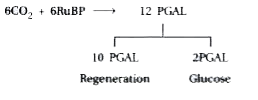Describe Calvin cycle. OR C3 pathway.
Text Solution
Calvin and his co-workes worked out the whole pathway and showed that the pathway operated in a cyclic manner, the RuBP was regenerated.
Calvin pathway occurs in all photosynthetic plants, it does not matter whether they have C3orC4 (or any other) pathways.
Calvin cycle can be described under three stages : (1) carboxylation (2) reduction (3) regeneration.
(1) Carboxylation : Carboxylation is the fixation of CO2 into a stable organic intermediate.
Carboxylation is the most crucial step of the Calvin cycle where CO2 is utillsed for the carboxylation of RuBP.
This reaction is catalysed by the enzyme RuBP carboxylase which results in the formation of two molecules of 3 - PGA.
Since this enzyme also has an oxygenation activity it would be more correct to call it RuBP carboxylase - oxygenase or RuBisCO.
(2) Redution : These are a series of reactions tha lead to the formation of glucose.
The steps invole utilisation of 2 molecules of ATP for phosphorylation and two of NADPH for reduction per CO2 molecule fixed.
2PGA+2ATP+2NADPH→2 Triose phosphate (2 PGAC)
The fixation of six molecules of CO2 and 6 turns of the cycle are required for the removal of one molecule of glucose from the pathway.

Regeneration : Regeneration of the CO2 acceptor molecule RuBP is crucial if the cycle is to continue uninterrupted. The regeneration steps require one ATP for PGALATP−−→RuBP
Hence for every CO2 molecule entering the Calvin , 3 molecules of ATP and 2 of NADPH are required.
It is probably to meet this difference in number of ATP and NADPH used in the dark reaction that the cyclic phosphorylation takes place.
To make one molecule of glucose 6 truns of the cycle are required.

|
Updated on:21/07/2023
Related Playlists
- BOOK - KUMAR PRAKASHANCHAPTER - PHOTOSYNTHESIS IN HIGHER PLANTSEXERCISE - SECTION - B (DIFFERENCE / SCIENTIFIC REASONS )(GIVE DIFFERENCE : (2 MARKS)9videos
PHOTOSYNTHESIS IN HIGHER PLANTS
- BOOK - KUMAR PRAKASHANCHAPTER - PHOTOSYNTHESIS IN HIGHER PLANTSEXERCISE - SECTION - C (DEFINITION / EXPLANATION - TERMS / LOCATION - FUNCTION / FULL NAME) (DEFINITIONS / EXPLANATION :(1 MARK)27videos
PHOTOSYNTHESIS IN HIGHER PLANTS
- BOOK - KUMAR PRAKASHANCHAPTER - NEURAL CONTROL AND COORDINATIONEXERCISE - OBJECTIVE SECTION (FILL IN THE BLANKS)12videos
NEURAL CONTROL AND COORDINATION
- BOOK - KUMAR PRAKASHANCHAPTER - PLANT GROWTH AND DEVELOPMENTEXERCISE - OBJECTIVE SECTION (FILL IN THE BLANKS)7videos
PLANT GROWTH AND DEVELOPMENT
Similar Questions
Calvin cycle is
View SolutionCalvin cycle is
View SolutionCalvin cycle is
View SolutionThe Calvin Cycle
View SolutionThe carbon dioxide acceptor in Calvin cycle/C3plants is
View SolutionThe carbon dioxide acceptor in Calvin cycle/C3plants is
View SolutionThe site of Calvin cycle in C4 plants is
View SolutionWhich of the following statements is incorrect regarding the Calvin cycle of C3 plants?
View SolutionWhich of the following statements is incorrect regarding the Calvin cycle of C3 plants?
View SolutionCalvin cycle / C3 pathway/Pathway taking place during day time in CAM plants .
View Solution

